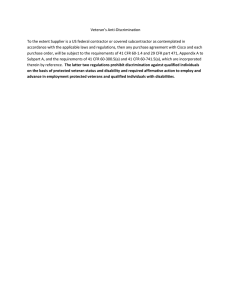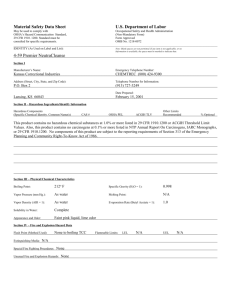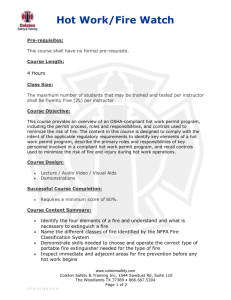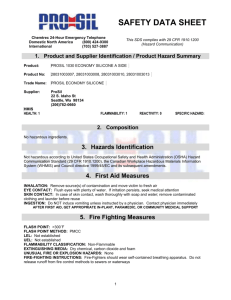Self Inspection Form 2012
advertisement
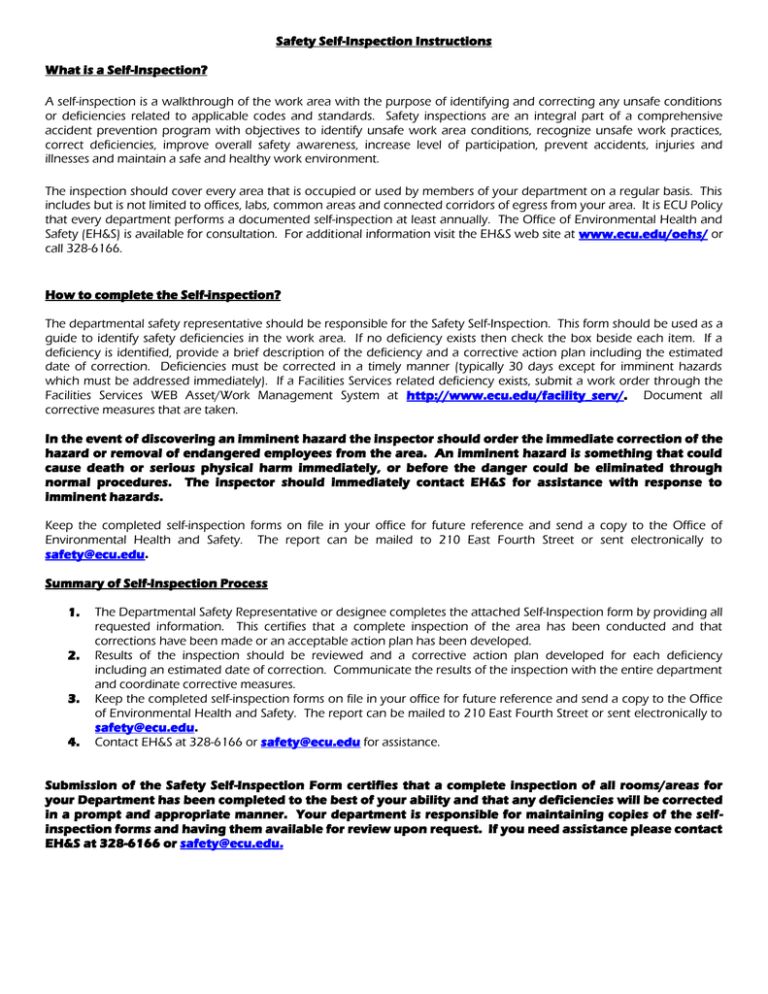
Safety Self-Inspection Instructions What is a Self-Inspection? A self-inspection is a walkthrough of the work area with the purpose of identifying and correcting any unsafe conditions or deficiencies related to applicable codes and standards. Safety inspections are an integral part of a comprehensive accident prevention program with objectives to identify unsafe work area conditions, recognize unsafe work practices, correct deficiencies, improve overall safety awareness, increase level of participation, prevent accidents, injuries and illnesses and maintain a safe and healthy work environment. The inspection should cover every area that is occupied or used by members of your department on a regular basis. This includes but is not limited to offices, labs, common areas and connected corridors of egress from your area. It is ECU Policy that every department performs a documented self-inspection at least annually. The Office of Environmental Health and Safety (EH&S) is available for consultation. For additional information visit the EH&S web site at www.ecu.edu/oehs/ or call 328-6166. How to complete the Self-inspection? The departmental safety representative should be responsible for the Safety Self-Inspection. This form should be used as a guide to identify safety deficiencies in the work area. If no deficiency exists then check the box beside each item. If a deficiency is identified, provide a brief description of the deficiency and a corrective action plan including the estimated date of correction. Deficiencies must be corrected in a timely manner (typically 30 days except for imminent hazards which must be addressed immediately). If a Facilities Services related deficiency exists, submit a work order through the Facilities Services WEB Asset/Work Management System at http://www.ecu.edu/facility_serv/. Document all corrective measures that are taken. In the event of discovering an imminent hazard the inspector should order the immediate correction of the hazard or removal of endangered employees from the area. An imminent hazard is something that could cause death or serious physical harm immediately, or before the danger could be eliminated through normal procedures. The inspector should immediately contact EH&S for assistance with response to imminent hazards. Keep the completed self-inspection forms on file in your office for future reference and send a copy to the Office of Environmental Health and Safety. The report can be mailed to 210 East Fourth Street or sent electronically to safety@ecu.edu. Summary of Self-Inspection Process 1. 2. 3. 4. The Departmental Safety Representative or designee completes the attached Self-Inspection form by providing all requested information. This certifies that a complete inspection of the area has been conducted and that corrections have been made or an acceptable action plan has been developed. Results of the inspection should be reviewed and a corrective action plan developed for each deficiency including an estimated date of correction. Communicate the results of the inspection with the entire department and coordinate corrective measures. Keep the completed self-inspection forms on file in your office for future reference and send a copy to the Office of Environmental Health and Safety. The report can be mailed to 210 East Fourth Street or sent electronically to safety@ecu.edu. Contact EH&S at 328-6166 or safety@ecu.edu for assistance. Submission of the Safety Self-Inspection Form certifies that a complete inspection of all rooms/areas for your Department has been completed to the best of your ability and that any deficiencies will be corrected in a prompt and appropriate manner. Your department is responsible for maintaining copies of the selfinspection forms and having them available for review upon request. If you need assistance please contact EH&S at 328-6166 or safety@ecu.edu. East Carolina University Safety Self-Inspection Form A safety self-inspection must be conducted in each department at least annually. The safety representative should complete (or oversee completion) the self-inspection form and coordinate corrective measures or development of an action plan to address each deficiency. The sections of the form and who must complete them are as follows: Section of Self Inspection Must be completed by: Section 1 – Emergency Procedures All departments Section 2 – Required Training and Other Information All departments Section 3 – Site Inspection Section 4 – Research Laboratories Section 5 – Areas / Departments Containing Hazardous Chemicals or Machinery Section 6 – Clinical Areas All departments Research laboratories that use chemicals, specialized equipment or engage in hazardous activities. Departments other than those with research laboratories, who use chemicals, specialized equipment or engage in hazardous activities. Departments and groups that are engaged in patient care. Keep a copy of the inspection form for your records and send a copy to the Office of Environmental Health and Safety (EH&S) at 210 East Fourth Street or safety@ecu.edu. Contact EH&S at 328-6166 or safety@ecu.edu for assistance. Building: Department: Safety Representative: Telephone/E-mail: Area(s) Inspected: Date of Inspection: If no deficiency exists then check the box. If a deficiency is identified, provide a description of the deficiency and corrective action plan including estimated date of correction. If a work order has been submitted, include tracking number. Section 1 – Emergency Procedures Emergency numbers are posted in conspicuous locations. The department has developed an emergency evacuation plan and employees are aware of their roles and responsibilities in this plan. Employees know the location of pull stations, fire extinguishers and other emergency equipment. If there is a fire alarm system in the work area, it was audible during the most recent evacuation drill/emergency. Deficiencies/Action Plan/Comments: Applicable Regulations: 29 CFR 1910.38 and NFPA 72-4.3.2.1* Section 2 – Required Training and Other Information All personnel have received appropriate safety training and instruction including but not limited to hazard communication. General Hazard Communication training is provided during new staff employee orientation and is also available online through the ECU OneStop – University Training. Employees are aware of the ECU policy statement on safety and environmental issues. Employees and students have been informed of their safety responsibilities including: compliance with applicable rules, regulations and policies; participation in training; and notification of supervisor of accidents, spills, damaged equipment, safety deficiencies, and prescription drug use or other conditions that may affect alertness or ability. Employees and students have received training on equipment operation, safety procedures, engineering controls, personal protective equipment, etc specific to the work area. The department retains training documentation and employee interviews/observations have been conducted to verify training effectiveness. Employees have been informed that they must report all accidents (including near-misses) to their supervisor and EH&S as soon as possible after the incident occurs. Employees are familiar with injury reporting procedures and documentation requirements. Employees have been informed that they have the right to make a complaint regarding unsafe or unhealthy workplace conditions by calling EH&S at 328-6166. Safety concerns should be addressed in-house through the supervisor and/or EH&S prior to contacting external agencies. Employees who are experiencing ergonomics issues should report them to their supervisor and then use the tools on the ergonomics web page to correct the issue. If needed, EH&S will conduct an assessment. Deficiencies/Action Plan/Comments: Applicable Regulations: OSHA Act of 1970 Section 5(a), 29 CFR 1977.22, 29 CFR 1904, 29 CFR 1977.9 Section 3 – Site Inspection Means of Egress All corridors, aisles, and other paths of travel are arranged and maintained to provide free and unobstructed egress from all parts of the building. See ECU policy on Means of Egress for additional information. All stairwells and corridors are maintained free of storage. Exits lights, emergency lights and other light sources are operational. Submit work order if deficiencies are noted. Stairwell doors and other fire/smoke doors function properly and are not propped open. Fire doors may be opened if they have an electromagnetic hold-open device that is connected to the fire alarm system. Interior decorations do not obscure, conceal or confuse exit doors, signs or exit pathways. Deficiencies/Action Plan/Comments: Applicable Regulations: NFPA 101 Chapter 5*, 29 CFR 1910.37, 2002 NC Fire Prevention Code Chapter 8* and 2002 NC Building Code Chapter 10.* Fire and Life Safety Space heaters and other unapproved heating devices are not used. Some space heaters create an extreme fire hazard and all interfere with building heating system. A minimum clearance of 3 feet is maintained in front of all electrical equipment/panels and emergency equipment including fire alarm pull stations, alarm panels and fire extinguishers. Ground fault circuit interrupter (GFCI) protected outlets are provided in wet areas and other areas listed in the NEC including, but not limited to, kitchens and bathrooms (GFCI may be provided at the main panel instead of at the individual outlets – protected outlets must be labeled) A minimum clearance of 18 inches is maintained below sprinkler heads. All areas are clean and orderly and maintained in a sanitary condition (report mold; mildew; excessive dust accumulations; leaking faucets, showers, and toilets; damage to floors, walls and ceilings; etc.) Areas are maintained free of trip hazards (holes, projections, cords, torn carpet, etc.) and slip hazards (spilled liquids, slick floor, etc.). Storage should be neat, limited to immediate use quantities and must not obstruct exits or means of egress. Storage is maintained at least eight inches off the floor. Paper on bulletin boards is not excessive. Combustible decorative materials must be flame resistant and may not exceed 20 percent of any individual wall area. Deficiencies/Action Plan/Comments: Applicable Regulations: NFPA 70-110*, NFPA 13-5-5.6*, NFPA 101-7.1.10.2*, 29 CFR 1910.157, 29 CFR 1910.159, 29 CFR 1910.22, and 2002 NC Fire Prevention Code 605.3*. General Office Equipment Extension cords are not used in place of permanent wiring. Approved extension cords may be used for some portable equipment, such as projectors and laptop computers. Otherwise, only UL listed surge protection strips may be used for personal computers. See extension cord policy for additional information. Electrical cords, plugs and receptacles are in good condition. Equipment is maintained in a state of good repair. A preventive maintenance program is in place to assure equipment is operational. Fans used in offices have guards to prevent finger contact. File cabinets and bookcases are secured to wall to prevent tipping over. When equipment malfunctions or is damaged it is tagged “Out of Service” until it is repaired by a qualified technician. Lockout/Tagout procedures are followed where appropriate. Operation manuals are available and all personnel have been trained in the proper operation of all equipment. Equipment is used only for the specific activity for which it was designed. Machine guards are provided and maintained in place to protect machine operators and other employees in the area from hazards such as those created by point of operation, ingoing nip points, rotating parts, flying chips and sparks. New operations/work activities are not added to the work area unless the existing facilities can support the operation or until facility modifications are made. All appropriate equipment and controls (local ventilation, etc.) must be in place and operational before the activity is performed. Modifications to the building are coordinated with Facilities Services and performed only by authorized personnel. Deficiencies/Action Plan/Comments: Applicable Regulations: NFPA 70-400-8,101-4.6.7*, 2002 NC Fire Prevention Code 605.4, 605.5, 605.7, and 605.8*, and 29 CFR 1910.212, 29 CFR 1910.303, 29 CFR 1910.147, 29 CFR 1910.242(a) . Section 4 – Research Laboratories Research Laboratories All laboratory personnel are required to complete the Lab Safety / Chemical Hygiene Plan training, available online. All laboratory personnel (faculty, staff, students and visitors) must understand the hazards present in the lab and how to protect themselves. All laboratory personnel must abide by the requirements set forth in the ECU Chemical Hygiene Plan. When equipment malfunctions or is damaged it is tagged “Out of Service” until it is repaired by a qualified technician. Lockout/Tagout procedures are followed where appropriate. Operation manuals are available and all personnel have been trained in the proper operation of all equipment. Equipment is used only for the specific activity for which it was designed. Machine guards are provided and maintained in place to protect machine operators and other employees in the area from hazards such as those created by point of operation, ingoing nip points, rotating parts, flying chips and sparks. New operations/work activities are not added to the work area unless the existing facilities can support the operation or until facility modifications are made. All appropriate equipment and controls (local ventilation, etc.) must be in place and operational before the activity is performed. Modifications to the building are coordinated with Facilities Services and performed only by authorized personnel. Please review the lab safety web page for additional information on ECU’s laboratory safety programs. Deficiencies/Action Plan/Comments: Applicable Regulations: 29 CFR 1910.1450, 29 CFR 1910.132- 139 Section 5 – Areas / Department Containing Hazardous Chemicals or Machinery (e.g. Facilities Services, Business Services) All containers are labeled with the complete chemical or product name and the appropriate hazard warning. Container and label integrity are monitored. Chemicals are in appropriate containers and storage cabinets and are stored according to compatibility. Corrosive chemicals are stored below eye level. Flammable liquids are stored in an approved safety can or flammable cabinet when amounts exceed 10 gallons. Chemical inventory is maintained, updated and submitted annually to EH&S. Inventory reduction measures have been implemented. Material Safety Data Sheets (MSDS) are available for each hazardous material and are readily accessible to all personnel. Each work area has developed safety plans for each area-specific activity involving the use of hazardous materials/equipment. Employees are familiar with the hazards associated with chemicals used or stored in the work area, signs and symptoms of exposure and measures they can take to protect themselves including appropriate work practices, engineering controls and personal protective equipment. Engineering controls (local exhaust ventilation, etc.) are in place for hazardous exposures. Gas cylinders are properly labeled and secured to prevent falling. Cylinders are stored according to compatibility and smoking/open flame restrictions are observed. Methods are utilized to minimize the quantity of chemical waste. Chemical waste disposal is coordinated with EH&S. The drain system is not used for chemical disposal. Smoking, eating, drinking and application of cosmetics is not allowed in work areas where chemicals and other hazardous substances are used or stored. Break areas are physically separated from the work area. When equipment malfunctions or is damaged it is tagged “Out of Service” until it is repaired by a qualified technician. Lockout/Tagout procedures are followed where appropriate. Operation manuals are available and all personnel have been trained in the proper operation of all equipment. Equipment is used only for the specific activity for which it was designed. Machine guards are provided and maintained in place to protect machine operators and other employees in the area from hazards such as those created by point of operation, ingoing nip points, rotating parts, flying chips and sparks. New operations/work activities are not added to the work area unless the existing facilities can support the operation or until facility modifications are made. All appropriate equipment and controls (local ventilation, etc.) must be in place and operational before the activity is performed. Modifications to the building are coordinated with Facilities Services and performed only by authorized personnel. Deficiencies/Action Plan/Comments: Applicable Regulations: 29 CFR 1910.1450, 29 CFR 1910.1200, 29 CFR 1910.106, 29 CFR 1910.141(g)(2), 29 CFR 1910.101, 29 CFR 1910.132- 139 and 40 CFR 260, NFPA 45*, NFPA 30*, and 2002 NC Fire Prevention Code Chapter 30*. Section 6 – Clinical Areas (those engaged in patient care) Identification badges are displayed by all ECU employees, vendors, and students working or involved in study in the clinics. Individuals not wearing badges, and not registered as patients, are asked if they need assistance. Equipment used for patient care has a current inspection sticker from Vidant’s Biomedical Department. Staff knows the procedure for reporting defective equipment or systems. Emergency power outlets (identified as red outlets) are used only for equipment which is essential for patient care during a power outage. Oxygen cylinders are maintained in an upright and secured position. Personal protective equipment, such as goggles, face shields, gloves and masks, are maintained in all sizes necessary for staff and are easily accessible. All employees required to wear N-95 or ‘TB masks’ have been medically evaluated as fit to wear the respirator and fit tested by the Office of Prospective Health. All areas that are used to store narcotics or sample prescription drugs are properly secured at all times. Patient charts and personal information is maintained to assure confidentiality. Key or unlock devices are available to unlock restrooms or exam rooms as necessary. Deficiencies/Action Plan/Comments: Applicable Regulations: Brody School of Medicine Code of Conduct, 29 CFR 1910.1450, 29 CFR 1910.132- 139, Joint Commission on Accreditation of Health Care Organizations Additional Comments:

